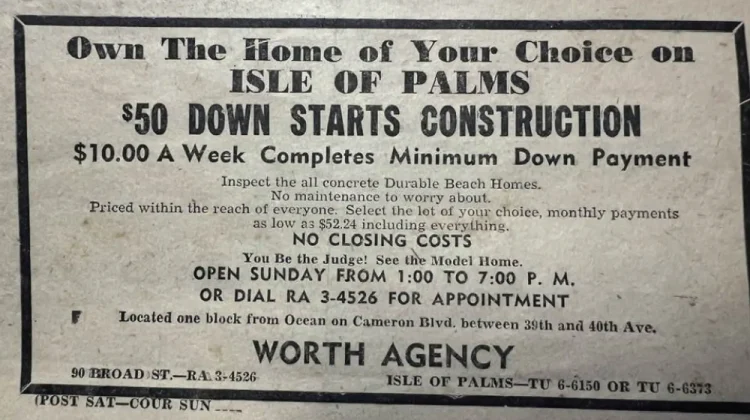Editor’s Note: From the Archives is a new ongoing history series featuring today’s landmarks on Isle of Palms and their past developments from yesteryear.

To own a property on the Isle of Palms with a down payment of $50, a monthly mortgage of $52.24 and no closing costs would seem a dream, even in the late 1950s or early ’60s.
However, a reading of the fie print in the advertisement reveals that the beach homes for sale were all-concrete. these houses, according to Sandy Stone, partially-retired ex-president of Island Realty, were poured with slabs that required cranes to lift them onto the walls and roofs.
Stone explained that a major issue with building a house using concrete is that its chemical component is unbreathable, so it is impossible to sweat any moisture out. In the summer, that meant a buildup of mold, mildew and a musty smell. An additional challenge with all-concrete structures in the days before air conditioning was that they became heat traps.
Aesthetically speaking, Stone said that while the interiors weren’t much to look at, the exteriors were “Textured somewhat to give a break in their appearance.”
However, concrete houses can offer significant resilience against hurricanes due to their inherent strength and durability, making them a good choice for hurricane-prone areas like IOP.
The homes, comprising approximately 700 to 900 square feet with two bedrooms and one bathroom, were developed by entrepreneur J.C. Long who, unsurprisingly, owned a cement business, along with a heating company, a mill and a workshop for cutting timber and lumber for later-built homes in the Forest Trail area. Stone said that Long fianced the properties for buyers who were mostly retirees, military or civilian physicians who wanted to hold property on the island. Additionally, second-home buyers from Greenville, Spartanburg and Columbia purchased the all-concrete houses for vacationing in the summer and then rented them out the other nine months of the year, using the income to cover their bills.
“As the market changed from the ’80s into the ’90s and 2000s, many homes on the island were bought for the lots,” Stone said. “These solid concrete houses were easy to buy and tear down to build something else or add on a more architecturally appealing extension. Along Cameron Boulevard, the 10-20-30-year-old properties are mostly new construction built on the footprint of those earlier concrete houses.” He added that as most of those original houses have been torn down, there is only one or possibly two that are still standing.
Although concrete homes are known for their longevity and minimal maintenance, they were not made popular by demand. Nevertheless, it would have been a savvy investment considering the price of island properties in today’s market.
By Sarah Rose




Leave a Reply